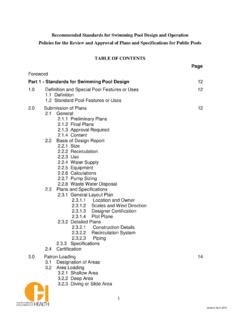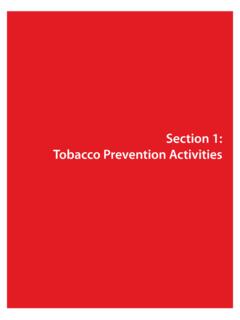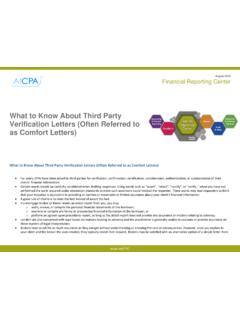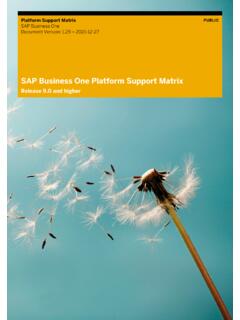Transcription of Infection Control Risk Assessment Matrix
1 Infection Control Risk Assessment Matrix of Precautions for Construction & Renovation Step One: Using the following table, identify the Type of Construction Project Activity (Type A-D) TYPE A Inspection and Non-Invasive Activities. Includes, but is not limited to: removal of ceiling tiles for visual inspection limited to 1 tile per 50 square feet painting (but not sanding) wall covering, electrical trim work, minor plumbing, and activities which do not generate dust or require cutting of walls or access to ceilings other than for visual inspection. TYPE B Small scale, short duration activities which create minimal dust Includes, but is not limited to: installation of telephone and computer cabling access to chase spaces cutting of walls or ceiling where dust migration can be controlled. TYPE C Work that generates a moderate to high level of dust or requires demolition or removal of any fixed building components or assemblies Includes, but is not limited to: sanding of walls for painting or wall covering removal of floor coverings, ceiling tiles and casework new wall construction minor duct work or electrical work above ceilings major cabling activities any activity which cannot be completed within a single workshift.
2 TYPE D Major demolition and construction projects Includes, but is not limited to: activities which require consecutive work shifts requires heavy demolition or removal of a complete cabling system new construction. Step 1_____Step Two: Using the following table, identify the Patient Risk Groups that will be affected. If more than one risk group will be affected, select the higher risk group: Low Risk Medium Risk High Risk Highest Risk Office areas Cardiology Echocardiography Endoscopy Nuclear Medicine Physical Therapy Radiology/MRI Respiratory Therapy CCU Emergency Room Labor & Delivery Laboratories (specimen) Newborn Nursery Outpatient Surgery Pediatrics Pharmacy Post Anesthesia Care Unit Surgical Units Any area caring for immunocompromised patients Burn Unit Cardiac Cath Lab Central Sterile Supply Intensive Care Units Medical Unit Negative pressure isolation rooms Oncology Operating rooms including C-section rooms Step 2_____ Step Three: Match the Patient Risk Group (Low, Medium, High, Highest) with the planned.
3 Construction Project Type (A, B, C, D) on the following Matrix , to find the .. Class of Precautions (I, II, III or IV) or level of Infection Control activities required. Class I-IV or Color-Coded Precautions are delineated on the following page. IC Matrix - Class of Precautions: Construction Project by Patient Risk Construction Project Type Patient Risk Group TTYYPPEE AA TTYYPPEE BB TTYYPPEE CC TTYYPPEE DD LLOOWW Risk Group II IIII IIII IIIIII//IIVV MMEEDDIIUUMM Risk Group II IIII IIIIII IIVV HHIIGGHH Risk Group II IIII IIIIII//IIVV IIVV HHIIGGHHEESSTT Risk Group IIII IIIIII//IIVV IIIIII//IIVV IIVV Note: Infection Control approval will be required when the Construction Activity and Risk Level indicate that CCllaassss IIIIII or CCllaassss IIVV Control procedures are necessary. Step 3_____ Description of Required Infection Control Precautions by Class During Construction Project Upon Completion of Project CLASS I 1.
4 Execute work by methods to minimize raising dust from construction operations. 2. Immediately replace a ceiling tile displaced for visual inspection 1. Clean work area upon completion of task. CLASS II 1. Provide active means to prevent airborne dust from dispersing into atmosphere. 2. Water mist work surfaces to Control dust while cutting. 3. Seal unused doors with duct tape. 4. Block off and seal air vents. 5. Place dust mat at entrance and exit of work area 6. Remove or isolate HVAC system in areas where work is being performed. 1. Wipe work surfaces with disinfectant. 2. Contain construction waste before transport in tightly covered containers. 3. Wet mop and/or vacuum with HEPA filtered vacuum before leaving work area. 4. Remove isolation of HVAC system in areas where work is being performed. CLASS III 1. Remove or Isolate HVAC system in area where work is being done to prevent contamination of duct system.
5 2. Complete all critical barriers sheetrock, plywood, plastic, to seal area from non work area or implement Control cube method (cart with plastic covering and sealed connection to work site with HEPA vacuum for vacuuming prior to exit) before construction begins. 3. Maintain negative air pressure within work site utilizing HEPA equipped air filtration units. 4. Contain construction waste before transport in tightly covered containers. 5. Cover transport receptacles or carts. Tape covering unless solid lid. 1. Do not remove barriers from work area until completed project is inspected by the owner s Safety Department and Infection Control Department and thoroughly cleaned by the owner s Environmental services Department. 2. Remove barrier materials carefully to minimize spreading of dirt and debris associated with construction. 3. Vacuum work area with HEPA filtered vacuums.
6 4. Wet mop area with disinfectant. 5. Remove isolation of HVAC system in areas where work is being performed. CLASS IV 1. Isolate HVAC system in area where work is being done to prevent contamination of duct system. 2. Complete all critical barriers sheetrock, plywood, plastic, to seal area from non work area or implement Control cube method (cart with plastic covering and sealed connection to work site with HEPA vacuum for vacuuming prior to exit) before construction begins. 3. Maintain negative air pressure within work site utilizing HEPA equipped air filtration units. 4. Seal holes, pipes, conduits, and punctures appropriately. 5. Construct anteroom and require all personnel to pass through this room so they can be vacuumed using a HEPA vacuum cleaner before leaving work site or they can wear cloth or paper coveralls that are removed each time they leave the work site.
7 6. All personnel entering work site are required to wear shoe covers. Shoe covers must be changed each time the worker exits the work area. 7. Do not remove barriers from work area until completed project is inspected by the owner s Safety Department and Infection Control Department and thoroughly cleaned by the owner s Environmental services Department. 1. Remove barrier material carefully to minimize spreading of dirt and debris associated with construction. 2. Contain construction waste before transport in tightly covered containers. 3. Cover transport receptacles or carts. Tape covering unless solid lid 4. Vacuum work area with HEPA filtered vacuums. 5. Wet mop area with disinfectant. 6. Remove isolation of HVAC system in areas where work is being performed. Step 4. Identify the areas surrounding the project area, assessing potential impact Unit Below Unit Above Lateral Lateral Behind Front Risk Group Risk Group Risk Group Risk Group Risk Group Risk Group Step 5.
8 Identify specific site of activity eg, patient rooms, medication room, etc. _____ Step 6. Identify issues related to: ventilation, plumbing, electrical in terms of the occurrence of probable outages. _____ Step 7. Identify containment measures, using prior Assessment . What types of barriers? (Eg, solids wall barriers); Will HEPA filtration be required? _____ (Note: Renovation/construction area shall be isolated from the occupied areas during construction and shall be negative with respect to surrounding areas) Step 8. Consider potential risk of water damage. Is there a risk due to compromising structural integrity? (eg, wall, ceiling, roof) Step 9. Work hours: Can or will the work be done during non-patient care hours? Step 10. Do plans allow for adequate number of isolation/negative airflow rooms? Step 11. Do the plans allow for the required number & type of handwashing sinks?
9 Step 12. Does the Infection Control staff agree with the minimum number of sinks for this project? (Verify against AIA Guidelines for types and area) Step 13. Does the Infection Control staff agree with the plans relative to clean and soiled utility rooms? Step 14. Plan to discuss the following containment issues with the project team. Eg, traffic flow, housekeeping, debris removal (how and when), _____ _____ _____ Appendix: Identify and communicate the responsibility for project monitoring that includes Infection Control concerns and risks . The ICRA may be modified throughout the project. Revisions must be communicated to the Project Manager. Infection Control Construction Permit Permit No: Location of Construction: Project Start Date: Project Coordinator: Estimated Duration: Contractor Performing Work Permit Expiration Date: Supervisor: Telephone: YES NO CONSTRUCTION ACTIVITY YES NO Infection Control RISK GROUP TYPE A: Inspection, non-invasive activity GROUP 1: Low Risk TYPE B: Small scale, short duration, moderate to high levels GROUP 2: Medium Risk TYPE C: Activity generates moderate to high levels of dust, requires greater 1 work shift for completion GROUP 3: Medium/High Risk TYPE D.
10 Major duration and construction activities Requiring consecutive work shifts GROUP 4: Highest Risk CLASS I 1. Execute work by methods to minimize raising dust from construction operations. 2. Immediately replace any ceiling tile displaced for visual inspection. 3. Minor Demolition for Remodeling CLASS II 1. Provides active means to prevent air-borne dust from dispersing into atmosphere 2. Water mist work surfaces to Control dust while cutting. 3. Seal unused doors with duct tape. 4. Block off and seal air vents. 5. Wipe surfaces with disinfectant. 6. Contain construction waste before transport in tightly covered containers. 7. Wet mop and/or vacuum with HEPA filtered vacuum before leaving work area. 8. Place dust mat at entrance and exit of work area. 9. Remove or isolate HVAC system in areas where work is being performed. CLASS III 1. Obtain Infection Control permit before construction begins.











